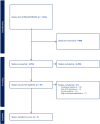Systematic review: risk prediction models for metachronous advanced colorectal neoplasia after polypectomy
- PMID: 39080790
- PMCID: PMC11660205
- DOI: 10.1111/jgh.16682
Systematic review: risk prediction models for metachronous advanced colorectal neoplasia after polypectomy
Abstract
Background and aim: Colorectal cancer (CRC) is the fourth leading cause of cancer death globally. CRC surveillance is a common indication for colonoscopy, representing a considerable burden for endoscopy services. Accurate identification of high-risk patients who would benefit from more intensive surveillance, as well as low-risk patients suitable for less frequent follow-up, could improve the effectiveness of surveillance protocols and resource use. Our aim was to identify and critically appraise published risk models for the occurrence of metachronous advanced colorectal neoplasia (ACN), defined here as CRC or advanced adenomas detected during surveillance colonoscopy.
Methods: We searched PubMed and EMBASE for primary research studies reporting the development and/or validation of multivariable models that predict metachronous ACN risk. Screening of studies for inclusion, data extraction, and risk of bias assessment were conducted by two researchers independently.
Results: We identified nine studies describing nine risk models. Six models were internally validated and two were externally validated. No model underwent both internal and external validation. Good model discrimination (concordance index > 0.7) was reported for two models during internal validation and for one model during external validation. Calibration was acceptable when assessed (n = 4). Methodological limitations and a high risk of bias were observed for all studies.
Conclusions: Several published models predicting metachronous ACN risk showed some promise. However, adherence to methodological standards was limited, and only two models were externally validated. Head-to-head comparisons of existing models using populations independent from model development cohorts should be prioritized to identify models suitable for use in clinical practice.
Keywords: cancer screening; colonoscopy; colorectal cancer.
© 2024 The Author(s). Journal of Gastroenterology and Hepatology published by Journal of Gastroenterology and Hepatology Foundation and John Wiley & Sons Australia, Ltd.
References
-
- Ferlay J, Soerjomataram I, Dikshit R et al. Cancer incidence and mortality worldwide: Sources, methods and major patterns in GLOBOCAN 2012. Int. J. Cancer 2015; 136: E359–E386. - PubMed
-
- Lieberman DA, Holub J, Eisen G, Kraemer D, Morris CD. Utilization of colonoscopy in the United States: results from a national consortium. Gastrointest. Endosc. 2005; 62: 875–883. - PubMed
-
- Belderbos T, Leenders M, Moons L, Siersema P. Local recurrence after endoscopic mucosal resection of nonpedunculated colorectal lesions: systematic review and meta‐analysis. Endoscopy 2014; 46: 388–402. - PubMed
Publication types
MeSH terms
Grants and funding
LinkOut - more resources
Full Text Sources
Medical


